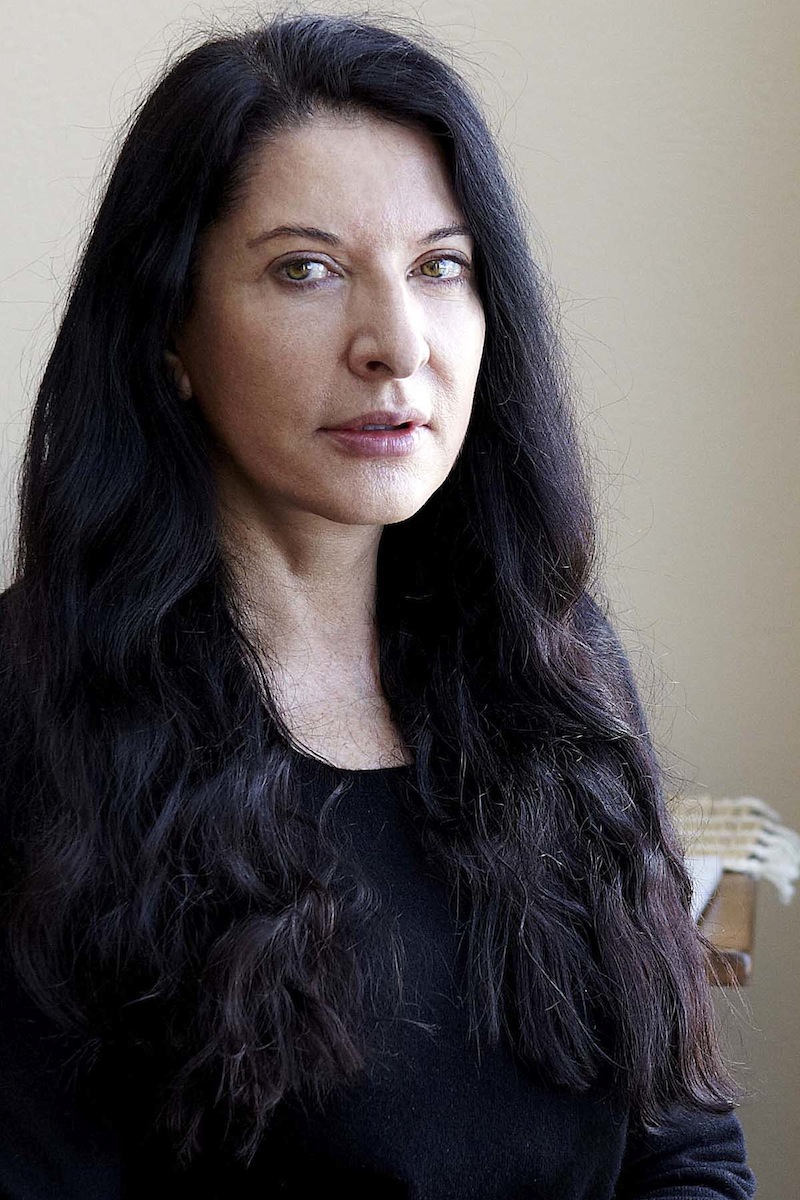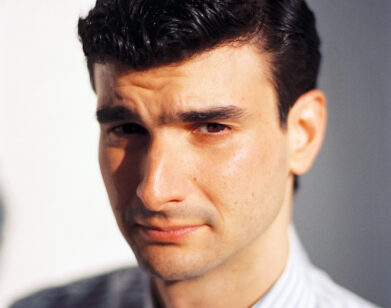Marina AbramoviÄ? Makes Sundance Shut Up
Born in 1946, Serbian performance art luminary Marina AbramoviÄ? visited Sundance this year in support of Matthew Akers’ documentary The Artist is Present, about her blockbuster and game-changing MoMA exhibition of the same name. From March–May 2010, AbramoviÄ? sat in the museum’s atrium during all open hours, while patrons were invited to sit across from her for as long as they desired. In the film, AbramoviÄ? recounts curator Klaus Biesenbach’s warning that she should be prepared for times when no one would sit across from her, but people lined up for hours before the museum opened and the chair never went empty. Ultimately, more than 15,000 people sat with her, many of whom cried; and a record-breaking 750,000 people visited the exhibition.
In previous performances, AbramoviÄ? has cut a star in her belly, thrown herself into walls, or whipped herself. Despite the austerity and self-destruction of many of her pieces, the film reveals AbramoviÄ? as a cheerful and effervescent person who is willing to laugh at herself. The morning after hosting a “silent” party to celebrate the new film, we spoke with AbramoviÄ? in her condo, braided her hair, laughed at the moose and bear-themed kitsch in her room, and helped her pick out furry winter accessories to wear on her busy day of press.
DEENAH VOLLMER: Last night you hosted a “silent” party, in which all attendees wore white headphones, white lab coats and were prohibited from speaking. Was this the first silent party you’d been to? Did you think it was successful?
MARINA ABRAMOVIÄ?: First of all, a general note about parties. Every party is the same, too many people, too little food, and you have to wait around. I’m extremely bored with parties. From that point of view, I was thinking I wanted to do something that I could be amused by. For my 50th birthday, I asked 450 people to learn an Argentinean tango. I called the party “The Urge to Dance.” Everyone who came had to be in a tuxedo, and beautiful dresses for women, in all colors but red because I was the only one in red. It took me about six months to organize because for every friend I invited, I also sent them the information about the closest tango school where they could go to learn before coming into the party. When you’re 50, the best thing to do is dance the Argentinean tango.
Then, I asked the director of the museum if he could make me a cake. He said, “Oh, you’re so old-fashioned, you don’t want any cake.” But then, five minutes before midnight, he surprised me and made an entire me out of marzipan. Every scar that I cut during my performances, he made out of chocolate. There were four gorgeous guys carrying this, like a stretcher. And then people just cut me and ate me. Then the door opened again, and it was the director himself, completely naked, live, with a bow tie. This was incredible because there were some American collectors there who couldn’t believe this. I mean, naked art director of a museum? This would have never happened in America.
Then my second party was at the Guggenheim, for my 60th. I also invited a huge amount of people. This was a huge celebration with Antony and the Johnsons singing. So for 70, I’m preparing something big. You’ll have to wait a little bit, five more years. So the next thing was to make a gala in Los Angeles for Jeffrey Deitch with live centerpieces and the naked women skeleton. Everyone wore lab coats. These erase identity so everyone is the same. The MoCA gala was very interesting because we’re talking Hollywood, we’re talking $30,000 dresses. People are getting dresses to be seen on the red carpet. Having a lab coat, the cook, the waiter, the Hollywood stars are all the same.
Then HBO said to me, “Let’s do something incredible at Sundance.” My movie is about silence, about a meditative state of mind, a different state of consciousness, and what it can do. I proposed a silent party to them. They said, “This is ridiculous. Nobody will understand. People have to talk about things.” And then I said, “Okay, that’s fine, do any party you want.” Then they said, “Do you have another idea?” And I said, “This is a good idea. We either do this, or not.” And then a week before they said, “Okay, let’s try.” That’s how this party came to be. I enjoyed myself very much. There was something warm about the situation. I could touch and hold people. It had this function of showing that communication can be on so many different levels. It doesn’t need to be empty conversation, which happens most of the time at parties. Whew, this was a long answer.
VOLLMER: It was a good answer. And a great party. My mom came with me to see the premiere on Friday. She’s a psychiatrist and a psychoanalyst. And she said, “I don’t know what the difference is between what Marina does and what I do.”
ABRAMOVIÄ?: Okay, I can answer that. The only difference is context. If you learn to be a psychoanalyst, and you’re working as a psychoanalyst, your job is in that context. If you’re a baker, making bread, you’re a baker. If you make the best bread in the world, you’re not an artist, but if you bake the bread in the gallery, you’re an artist. So the context makes the difference. And my context is art. That’s why people say, you can sit on top of a mountain and be a yogi, what’s the difference? Again, the context. I’m not a yogi. I’m not on the mountain. I function as an artist. That’s the difference.
VOLLMER: You mention in the film that you went to analysis.
ABRAMOVIÄ?: Yeah, I had to do that for the first time in my life. Because I was divorcing. God, it was a mess.
VOLLMER: Is there anything that you took from your own analysis to your performance at the MoMA?
ABRAMOVIÄ?: You know, it’s an interesting question that I’m not usually asked. I never went to a psychologist. I always thought the more fucked-up childhood you have, the better artist you get, because you have more material to work with. I don’t think anyone does anything from happiness. Happiness is such a good state, it doesn’t need to be creative. You’re not creative from happiness, you’re just happy. You’re creative when you’re miserable and depressed. You find the key to transform things. Happiness does not need to transform.
I really had a difficult background, so I’ve done all my work using this. But when my husband left, and we were divorcing, it was something I couldn’t deal with. I really wanted to understand what went wrong. So I went to this psychoanalyst. It was so painful, it was so horrible. I have to say, yes, maybe it helped. But I was just in Brazil, and I went to meet two Shamans, and I spent five days with them on a special retreat in the forest. These three days really fixed me more than three years of psychoanalysis. I understood on the deepest subconscious level what it takes psychoanalysis years to do. But America is obsessed with psychoanalysis. When I came to America everyone asks, “Who’s your psychoanalyst” like “Who’s your dentist?” “What? You don’t have one?”
VOLLMER: I read in the interview you did with the Wall Street Journal that you felt unconditional love for every person you sat with at the MoMA. I sat with you and that was my experience, too.
ABRAMOVIÄ?: Unconditional love with someone you’ve never met is a straightforward feeling that is so overwhelming and fulfilling. It’s not easy to do. I was trying to set up a zone where I was really empty. I am receiver and sender at the same time. Then I can open myself and be vulnerable and this other person can actually feel comfortable to let it go, all of his pain and wandering, and feel that I am unconditionally in love and I don’t want anything out of this. Talking about performance is such a strange thing because it’s so immaterial. We are talking about soft matter. We are talking about something that is invisible. You can’t see it. You can’t touch it. You just can feel it. At the same time, performance has this amazing power of transformation which other mediums have too, but it’s much more difficult to get it. This is more direct. It’s so instant.
VOLLMER: So when you were sitting in the MoMA, or performing any of the pieces that you’ve done, have you ever felt like you are faking it or being insincere? Are there any moments when you doubt yourself?
ABRAMOVIÄ?: You know, I am probably the luckiest person in the world—that I really don’t doubt. Performance became a kind of holy thing for me. First of all, to do performance art, you really have to give 100 percent. I only know that I have to give 100 percent and then what happens, happens. And in my life, I really never fake. You know, Bruce Nauman’s said, “Art is the question of life and death.” This may sound melodramatic, but it’s so true. I really believe in it, I believe that you have to give a 100 percent and that’s it. And then if people take it or not take it, criticize it, you can’t do anything more because you have given it a 100 percent. And anything less does not work. This is why the performance can be transformative.
There are so many bad performances, at least that I saw in my life and I have to say I made a few of them myself. There is one that I remember in the ’70s. I was doing it and in the middle of the performance I started to think, this is huge bullshit. It was incredible. I got so sick, I had a temperature, I was vomiting. Physically, I was completely out. But this experience is important because failure is a very important part of being an artist. You have to risk in your work. And if you risk, you go to completely unknown territory and so you can fail. And the failure is a big learning process. If you don’t risk, it means you are always doing the same thing. Then you are so boring and you can never surprise yourself. I hate repetition. Even when I am home and have to buy milk, I go a different way each time to avoid having a habit of anything. Habits are really bad. So to me it is really important to live in what I call the spaces in-between. Bus stations, trains, taxis or waiting rooms in airports are the best places because you are open to destiny, you are open to everything and anything can happen because you are out of this kind of protection you build around yourself. For me, I hate studio. First of all, studio is a trap. You go to a studio to make new work. It doesn’t work. You have to live your life and ideas come from a surprise, whether cutting an onion, going to the bathroom or walking in the street.
VOLLMER: Do you feel like your ideas ever come from a political place in addition to a personal place?
ABRAMOVIÄ?: Art should have political, spiritual, and surprising elements. It should try to find new language of communicating in order to give awareness to the public. Then every society can use the layer it needs at the moment. If one is interested in the political, they can take that. If the next one needs spiritual, it can be found in the same work. So if you just did one level, for example only political, it’s like an old newspaper, you read it today and tomorrow it’s old news. The art dies. Art with this kind of complexity has many lives where many societies can take something different at different times. It can live for centuries, otherwise who cares?
VOLLMER: You mentioned that the film captures many different sides of you. Do you think there were any sides that were missing from the film?
ABRAMOVIÄ?: God. Maybe that I’m afraid of sharks. But I don’t know. We didn’t go to the water. I think so many people criticize my love of fashion. You know, in the ’70s, if you wore lipstick, which I actually do today, or nail polish or anything, you were not a good artist, you were just a slut. It was always ugly clothes, boots with holes and leather jackets. When I turned 40, I walked the Chinese Wall and I said goodbye to all of that. I felt ugly, fat and unwanted. I was feeling so terrible and this is the moment I told myself I don’t need to prove myself I am an okay artist. I went to the hairdresser. I changed myself. I bought my first fashionable clothes with the first money I had. It was Yamamoto; I still have the same suit. But the thing is, yes it is vanity, but why not? And everyone has so many different faces to show to the public, but most of the people show just one aspect and than hide the rest, from drug addiction to whatever. I never drink, I don’t take drugs, I’m really not interested in that. It’s just a very normal life; I actually hate parties. I never go out. But I like fashion. I like to eat tons of chocolate. You can give me any amount, I can finish it. I like bad movies. I like kitschy stories, like everybody else. When I perform, I perform from the highest of myself but then when you reach this thing you need release. You just need ice cream after this, and that is what I am saying to the public. So I don’t think I hide anything at all in this movie.
VOLLMER: In the film, you said artists shouldn’t love other artists. Why?
ABRAMOVIÄ?: Because it’s always tragedy. One example where it’s not is Gilbert and George, but they are gay and they stayed together forever. But with two artists, if one is more successful, the other is jealous, or one stops working and starts helping the other one and just forgets his career, or they separate and never talk to each other. I mean there are endless combinations in which it doesn’t work. I really studied it.
VOLLMER: Performance art has reached the mainstream and is really being appreciated now more than ever before, in great part due to you. Why do you think that is?
ABRAMOVIÄ?: It is not that I am not modest, but I really think I have done some big contribution to this. I am really ’70s generation and most of the performance artists at the end of the ’70s stopped performing because there was no money and nothing to sell. So the performance artists became painters. They started doing installations, and they stopped performing. I understood the need for re-performing, especially for historical pieces so that performance can be live, not video. When I did ’70s pieces in Guggenheim, I re-performed historical pieces. I asked every single performances artist for the permission. I paid for the permission and I made my own version and I credited them. This was a way to see and to review performance in a new way. The economic crisis is always good for performance artists because people can’t afford to buy art. Performance art is low maintenance, which is good because it gives back more sense of what art should be.
FOR MORE ON MARINA ABRAMOVIÄ? THE ARTIST IS PRESENT, CLICK HERE.







